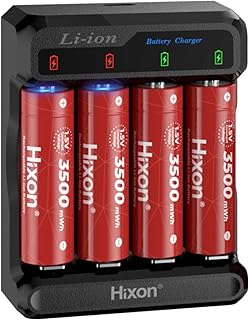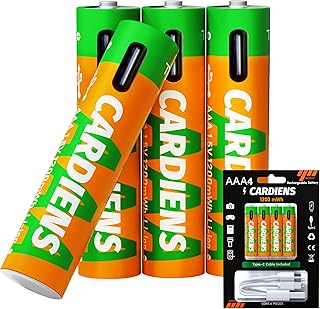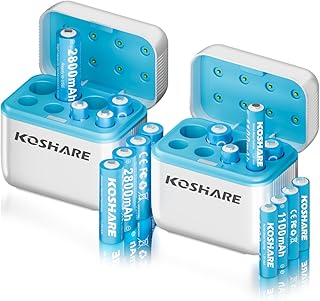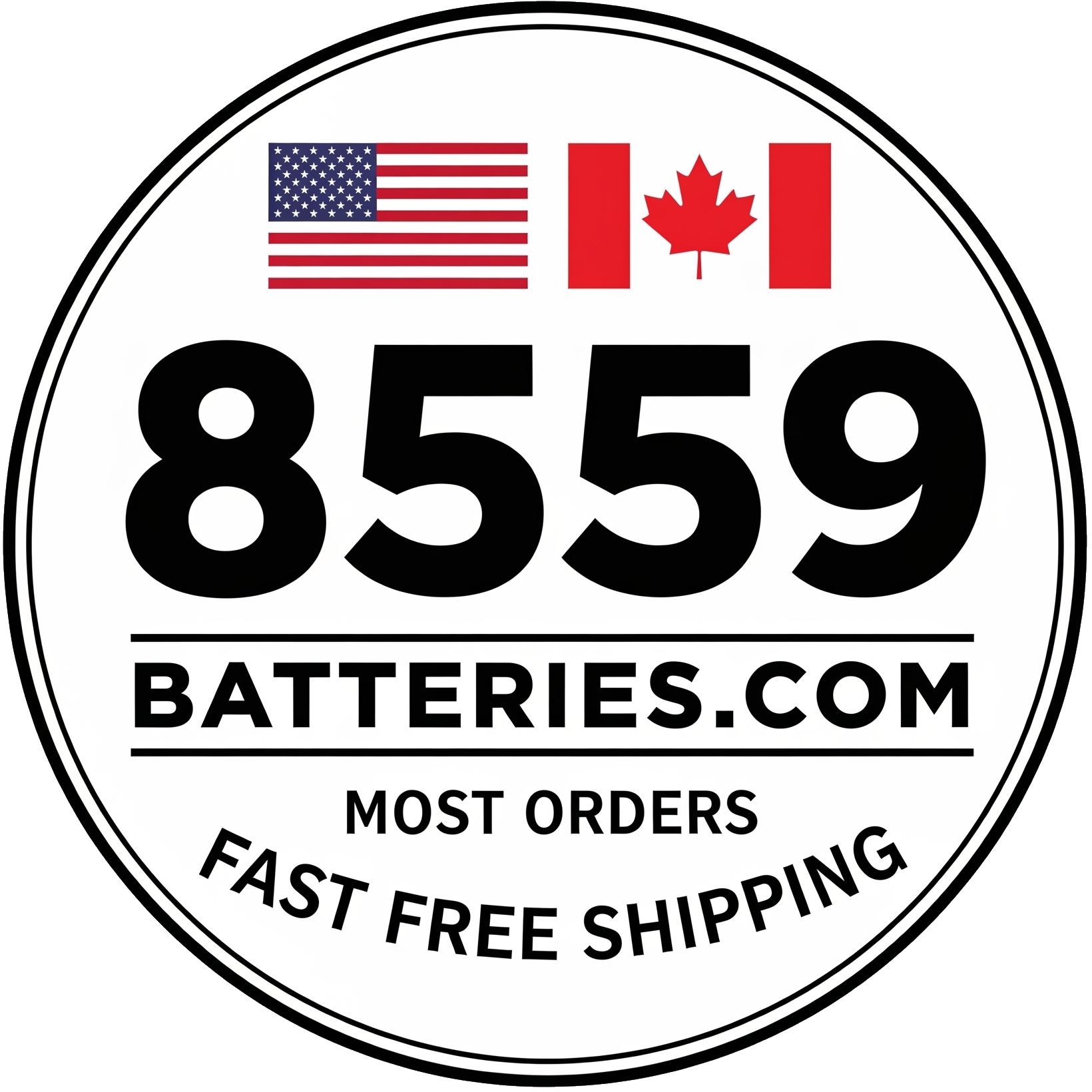Shop Products in USA

21700 3.7V Rechargeable Battery with Charger 5000mAh Battery Large Capacity Batteries for Flashlight Headlamps Doorbells Toys etc(2 Pack Battery+Charger
4.40
(35 reviews)
$24.91
Delivery Wed, Sep 10 Ships to Canada

(5-Pack) Sub C 1.2V 2000mAh Ni-CD Rechargeable Batteries with Tabs for Power Tools, Cordless Drills, Emergency Lights, High Drain Devices
4.50
(186 reviews)
$9.99
Delivery Thu, Sep 11 Ships to Canada

Hixon 1.5V Rechargeable AA Batteries 4 Count 3500mWh AA Rechargeable Lithium Batteries with 2H Voice Battery Charger, Long Lasting and Constant Voltage Output for Controllers, Toys, Microphones
4.10
(125 reviews)
$23.99
Delivery Wed, Sep 10 Ships to Canada

Rechargeable AAA Batteries USB C 1200 mWh Triple AAA Rechargeable Battery 1.5V AAA Lithium Batteries with 4-in-1 Charging Cable and LED Charge Indicator, 4-Pack
4.30
(238 reviews)
$9.99
Delivery Wed, Sep 10 Ships to Canada

Rechargeable Batteries Ni-MH with Chargers,1.2V 2800mAh AA and 1100mAh AAA,2 Box of 16 Ni-MH Battery AA AAA,Reach up to 800 Times,Pre-Charged (White+Blue, (4AA4AAA+8Slot Charger)*2)
3.90
(6 reviews)
$38.73
Delivery Wed, Sep 10 Ships to Canada

PowerOne ACCU Plus Size 13 (recharg)
Rechargeable size 13 NiMH hearing aid batteries (1.2 V, ~28 mAh) for devices designed to use replaceable rechargeables. Typical runtime 7–12 hours per charge; full charge in about 3–5 hours; service life up to ~800 charge cycles depending on use. Works with PowerOne chargers; not for ZPower silver-zinc or built-in Li-ion systems. Confirm compatibility with your hearing aid or audiologist before switching.
About PowerOne ACCU Plus Size 13 (recharg)
PowerOne ACCU Plus Size 13 Rechargeable Hearing Aid Batteries
PowerOne ACCU Plus 13 are nickel–metal hydride (NiMH) button cells that replace disposable size 13 zinc‑air batteries in hearing aids designed for rechargeables. They deliver a stable 1.2 V, around 28 mAh capacity, and can be recharged many times for a lower total cost and less waste than disposables.
When to choose these batteries
- Use if your hearing aid is labeled for “rechargeable size 13 NiMH” cells or supports replaceable rechargeables.
- Use if you want daily charging with predictable run time and less battery waste.
- Avoid if your device relies on ZPower silver‑zinc cells, has a built‑in Li‑ion battery/charger, or specifies zinc‑air only.
- Avoid if you need multi‑day run time between charges; zinc‑air size 13 typically runs much longer per cell.
Key specs
| Battery size / code | 13 (orange tab), button cell |
| Chemistry | NiMH (nickel–metal hydride) |
| Nominal voltage | 1.2 V |
| Typical capacity | ~28 mAh |
| Typical runtime per charge | 7–12 hours (4–8 hours with heavy Bluetooth streaming) |
| Recharge time | ~3–5 hours to full |
| Cycle life | Up to ~800 cycles (usage and depth of discharge dependent) |
| Charger compatibility | PowerOne Pocket/Pen chargers with size 13 insert |
Runtime and charging tips
- Expect 7–12 hours per charge in typical use; intensive features (e.g., streaming, noise reduction, high gain) reduce runtime.
- Charge nightly. Partial charges are fine—modern NiMH has no meaningful memory effect.
- First few cycles: capacity may improve slightly after 3–5 full charges.
- If unused for a week or more, expect some self‑discharge; top up before wearing.
Compatibility notes
Only use in hearing aids that explicitly accept rechargeable size 13 NiMH cells. Voltage (1.2 V) and charging method differ from zinc‑air and silver‑zinc systems.
- Not compatible with ZPower silver‑zinc chargers/systems or devices with integrated Li‑ion charging cradles.
- Do not assume any “size 13” aid will work—confirm in your manual or with your audiologist.
- Do not mix chemistries (e.g., never charge a zinc‑air battery).
How to use
- Confirm your aid supports NiMH size 13 rechargeables.
- Insert the battery (orange tab side out). Ensure correct polarity.
- Charge in a compatible PowerOne charger until full (LED or indicator shows ready).
- Rotate two batteries daily: one in use, one on charge, for uninterrupted wear.
- Wipe battery and aid contacts with a dry cloth weekly to maintain a solid connection.
Pros and cons
- Pros: Reusable (hundreds of cycles), predictable daily routine, less waste, no mercury.
- Cons: Shorter daily runtime than zinc‑air; requires compatible charger and nightly charging; performance varies with streaming.
Alternatives
- Zinc‑air size 13 (disposable): Longest single‑cell runtime (often several days); ongoing purchase and waste; no recharging.
- Built‑in Li‑ion hearing aids: All‑day runtime with dock charging; requires upgrading devices; non‑user‑replaceable batteries.
- Silver‑zinc (ZPower): Legacy systems with different voltage/chargers; generally not cross‑compatible with NiMH.
Care, safety, and recycling
- Keep batteries away from children and pets; button cells are a choking and ingestion hazard.
- Do not short‑circuit, crush, or expose to heat or water.
- Store in a cool, dry place (50–77°F / 10–25°C). Avoid leaving in hot cars.
- Recycle at battery collection points; do not incinerate.
FAQ
Will the 1.2 V NiMH damage my hearing aid?
No—if your aid is specified for rechargeable NiMH size 13, 1.2 V is expected. If your aid requires zinc‑air only, do not use NiMH.
How many hours will I get per charge?
Most users see 7–12 hours. Continuous streaming or high amplification can reduce this to 4–8 hours.
Can I charge the battery while it’s inside the hearing aid?
Only if your manufacturer provides a compatible charging dock designed for removable NiMH cells. Otherwise, remove the battery and use a PowerOne charger.
How long will the batteries last overall?
Up to around 800 cycles is typical, depending on depth of discharge, temperature, and handling. Replace when run time noticeably shortens.
What if my aid shows a low‑battery warning sooner than expected?
Reduce streaming, ensure contacts are clean and fully charged, and verify the aid is set for rechargeables. If issues persist, consult your audiologist.


